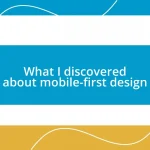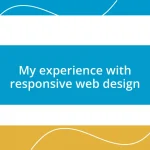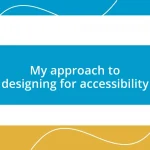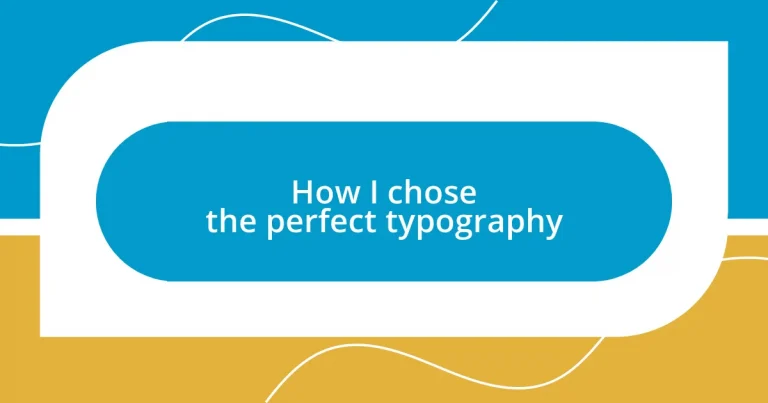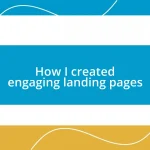Key takeaways:
- Typography is instrumental in conveying emotions and messages, influencing audience connection and perception.
- Identifying design goals, understanding the target audience, and considering context are essential when selecting a typeface.
- Mixing fonts requires balancing contrast and harmony to enhance readability and aesthetic appeal.
- Testing typography across different applications and gathering user feedback ensures effective design and enhances user experience.
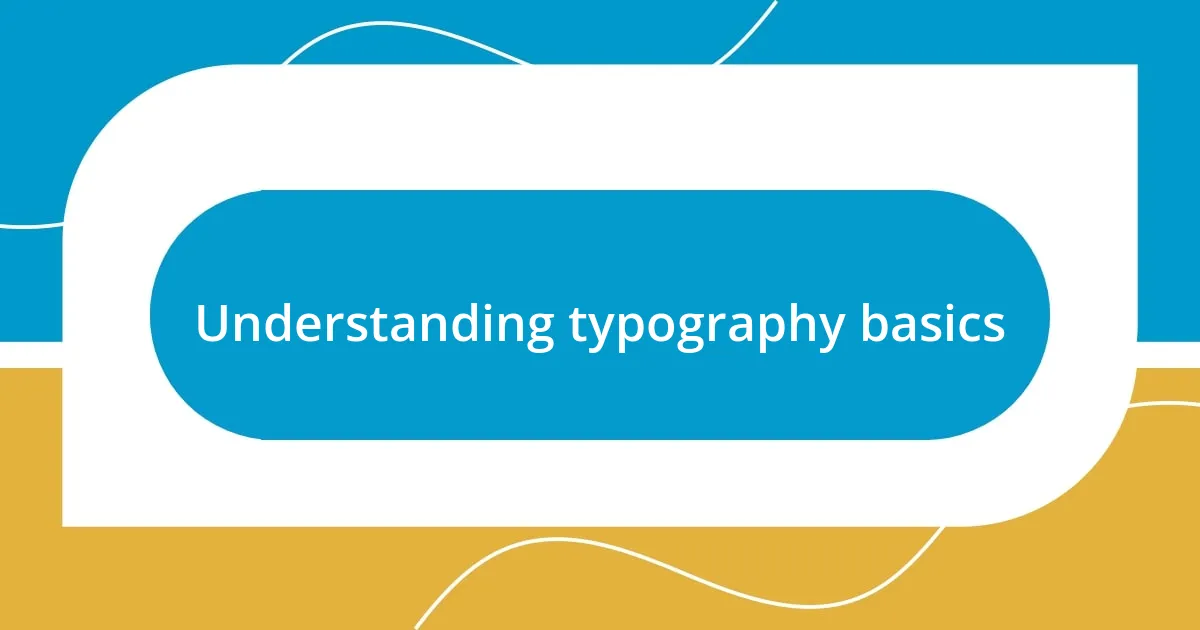
Understanding typography basics
Typography is more than just a visual element; it evokes emotions. I remember the first time I came across a beautifully crafted serif font. It seemed to whisper elegance while making the text feel inviting. Have you ever noticed how certain typefaces can make you feel instantly more connected to the words you’re reading?
Choosing the right typeface can feel overwhelming, especially with endless options at your fingertips. For me, understanding the difference between serif and sans-serif fonts was a game changer. Serif fonts, with their little feet, often exude tradition and reliability, while sans-serif fonts deliver a modern simplicity that can be refreshing. When I’m designing, I often pause and ask myself: what message do I want to convey, and how can my choice in font help achieve that?
Legibility is another cornerstone of effective typography. I vividly recall a project where I used a fantastic script font for an event flyer. Unfortunately, it looked stunning but was nearly impossible to read from a distance. It taught me that while aesthetics matter, clarity is key—after all, if your audience can’t read the text, what’s the point?
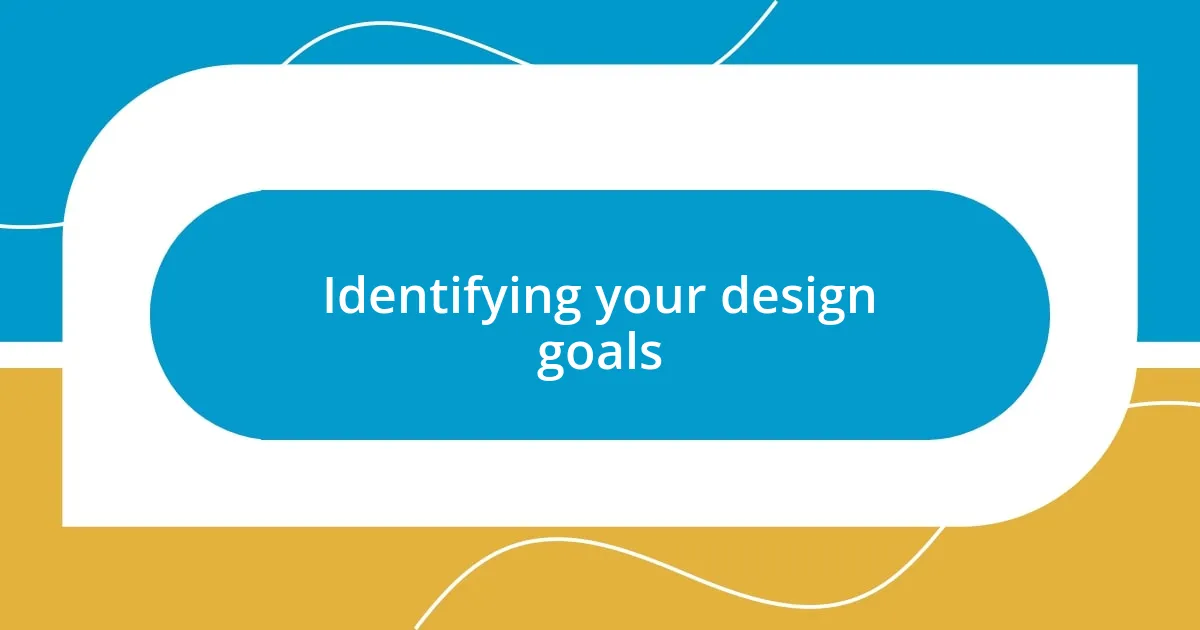
Identifying your design goals
Identifying your design goals is a crucial step in the typography selection process. When I embark on a new project, I always start by asking myself what message I want to communicate. For instance, during a recent branding project, I aimed for a warm and friendly feel. By considering my design goals upfront, I was able to choose a typeface that complemented the brand’s personality beautifully.
Another aspect to think about is your target audience. Understanding their preferences and expectations can guide your typography choices. I learned this firsthand when designing a website for a younger demographic. I opted for a clean, sans-serif font that not only appealed to their modern sensibilities but also ensured readability across devices. It’s fascinating how typography can bridge the gap between the designer’s vision and the audience’s needs.
Lastly, remember to consider the context in which your typography will appear. I recall working on a project for a luxury hotel that required an elegant touch. Selecting a refined serif font elevated the overall aesthetic and aligned perfectly with the brand’s upscale identity. Keeping the design goals at the forefront allowed me to make cohesive, impactful typography choices.
| Design Factor | Consideration |
|---|---|
| Message | What emotion or idea should the typography convey? |
| Target Audience | What preferences and characteristics does the audience have? |
| Context | Where and how will the typography be used? |
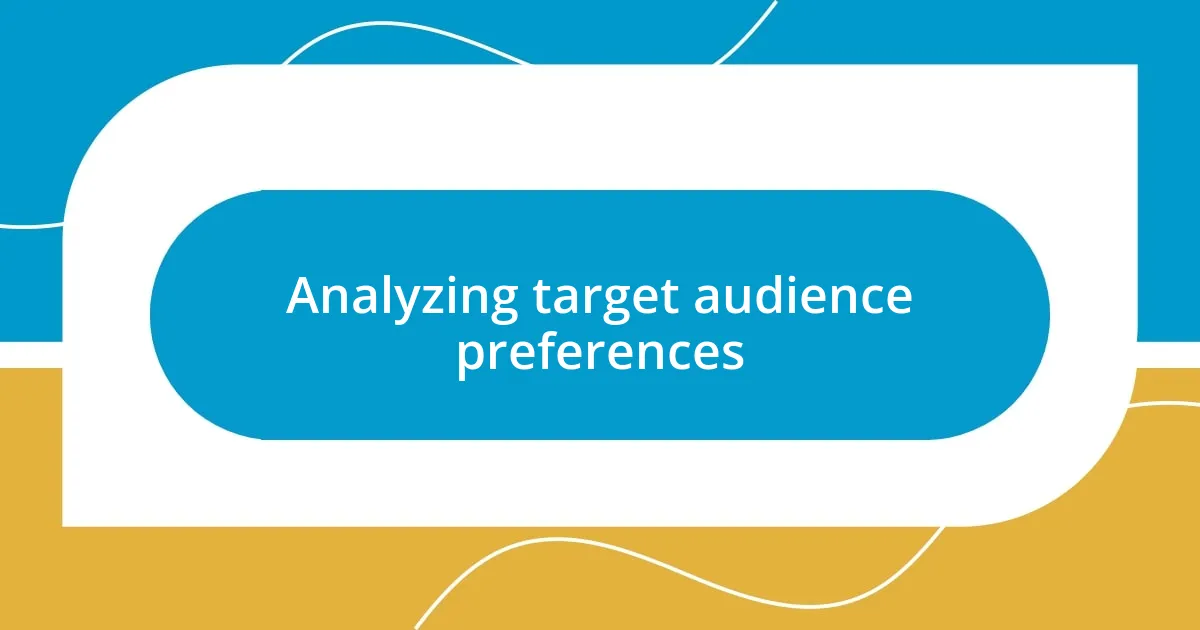
Analyzing target audience preferences
Analyzing your target audience’s preferences is vital to choosing the perfect typography. I remember a time when I was designing a poster for a local music festival aimed at teenagers. I opted for a bold, playful font that not only resonated with their vibrancy but also matched the festival’s energetic theme. By immersing myself in their interests and preferences, I made sure the typography stood out and captured their attention.
Understanding your audience goes beyond just demographics; it’s about connecting with their emotions and aspirations. Here’s what I focus on:
- Age Group: Different age groups often respond uniquely to typography. Younger audiences may prefer contemporary styles, while older demographics might gravitate towards more classic fonts.
- Lifestyle and Interests: Knowing what excites your audience can guide the font style. For instance, a fitness-oriented audience might appreciate a modern, bold typeface to reflect an active lifestyle.
- Cultural Background: Certain fonts may resonate more with specific cultural groups. I recall incorporating traditional scripts when designing for a multicultural event to honor diverse backgrounds.
- Readability Preferences: Some audiences prioritize simplicity and clarity, while others might appreciate more artistic flair. Tailoring your typography to these nuances can enhance engagement.
By genuinely understanding these aspects, I’ve been able to craft designs that truly resonate with the intended audience, turning them from mere viewers into emotionally connected participants.
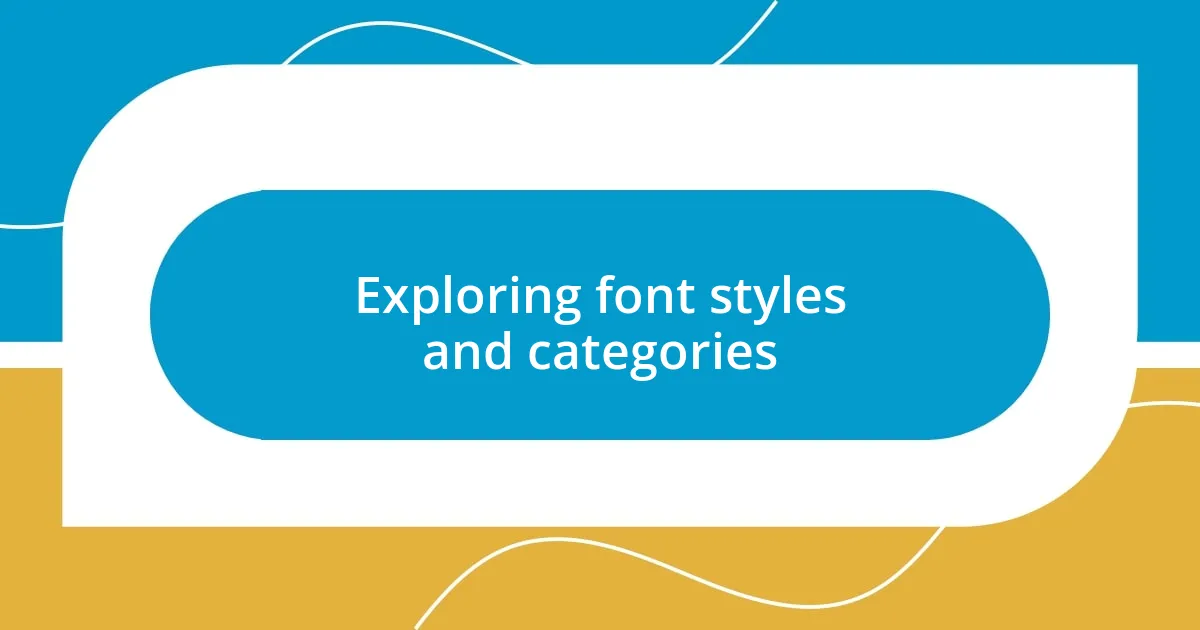
Exploring font styles and categories
Exploring the world of font styles and categories can feel overwhelming at first, but I find that breaking it down makes it so much easier. For instance, I always categorize fonts into three main groups: serif, sans-serif, and script. I remember my first time choosing a font for an artsy blog; leaning toward a playful script font was tempting, but I realized a sans-serif typeface would be more fitting for a clean and modern look. It’s all about matching the right font to the project’s vibe, don’t you think?
On another occasion, I was tasked with revamping a corporate website, which called for a more sophisticated touch. I leaned heavily into serif fonts, as they exude a sense of professionalism and tradition. The difference was striking. I could almost feel the website’s credibility boost with this subtle change, showing how intentional typography can transform a brand’s perception. Isn’t it fascinating how these choices can influence how people view a company?
Lastly, I learned the hard way that handwritten or display fonts, while unique, should be used sparingly. During a branding project for a boutique, I went all out with a fancy font. Initially, it felt fresh and trendy, but feedback showed it hindered readability. I realized then that the life and personality of a brand must coexist with practicality in font selection. Isn’t it interesting how less can sometimes mean more when it comes to design?
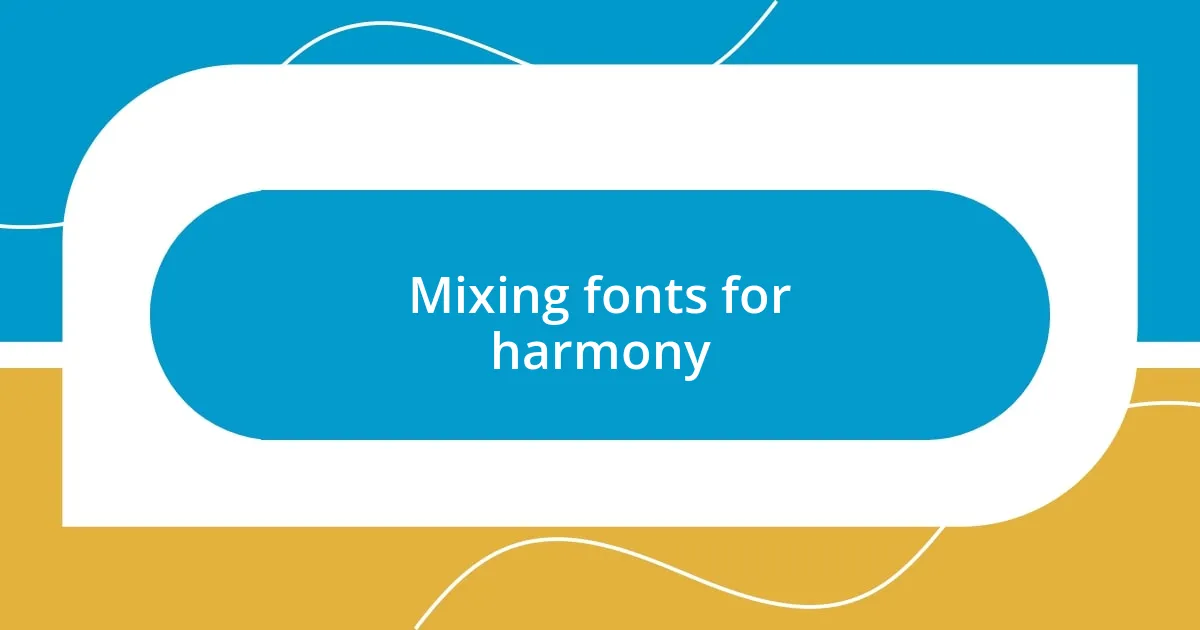
Mixing fonts for harmony
Mixing fonts for harmony is like creating a melody; it requires a delicate balance. I recall a project where I needed to blend a headline font with a body text font for a community newsletter. I chose a bold, eye-catching sans-serif for the headlines and paired it with a clean, simple serif for the body. The contrast not only drew attention to important messages but also maintained readability. Don’t you find it interesting how the right combination can elevate the overall design?
I’ve learned that when mixing fonts, contrast is key yet harmony remains essential. For instance, while working on an event branding project, I opted for a modern sans-serif for the main content and paired it with a classic serif for quotes. The end result was visually appealing and provided a sophisticated feel without overwhelming the reader. What’s your take on balancing modernity with tradition in typography?
Sometimes, it’s helpful to create a small mood board to see how different fonts interact before finalizing my choices. The last time I did this, I found the perfect duo: a bold, playful font juxtaposed with a soft, gentle script for an invitation design. Seeing those fonts together sparked a creative joy in me, and it was clear they would create a warm, inviting aesthetic that matched the event’s theme. Have you ever experienced that moment when the perfect combination clicks into place? It’s truly magical!
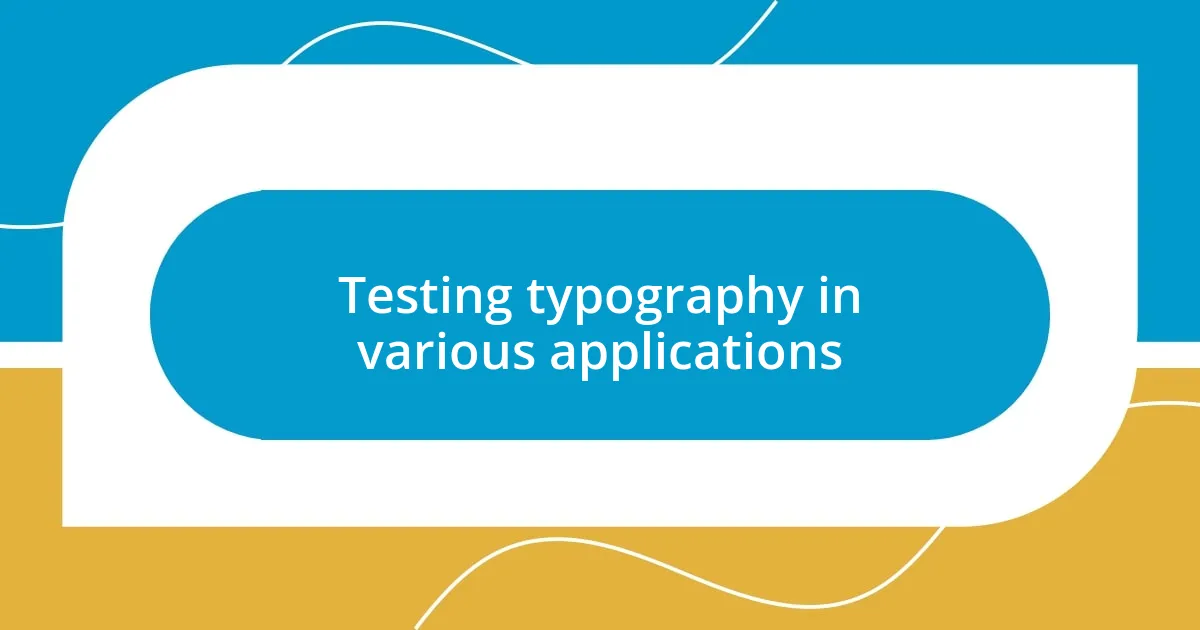
Testing typography in various applications
When it comes to testing typography, I always emphasize real-world applications. Recently, I worked on an app interface, which required me to assess how different fonts performed under various screen sizes. I initially chose a trendy sans-serif, but once I tested it on mobile devices, I realized it was too cramped. Opting for a slightly wider font not only improved legibility but also created a better user experience. Have you experienced similar challenges in making typography work in digital spaces?
I also enjoy printing samples to see how fonts translate from screen to paper. For instance, while designing a flyer for a local market, I printed two versions—one with a sleek sans-serif and another with a warm serif. Surprisingly, the serif version provided a charming touch that resonated with the community. It truly brings me joy to witness how a typeface can take on a new life when interacting with different mediums, don’t you think?
Moreover, I find it incredibly useful to gather feedback from real users. Once, during a project for a nonprofit, I brought several font options to a community meeting. The conversations that sparked around readability and personal preference were enlightening. It demonstrated how different fonts can evoke different feelings and connections. Engaging others in your typography choices not only refines the selection but creates a shared sense of ownership in the design process. Isn’t it rewarding when the community feels a part of your creative journey?


